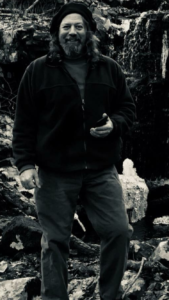
You Might be a Mountain Man if…
If you live on a mountain and regularly send pictures of nosy black bears sniffing around your front door and casually note in your email: “Had some visitors last night,” then, you might be a mountain man. Meet Tim Jones. He is: “The Stissing Mountain Man.”
Tim Jones lives on Stissing Mountain, located in the Hudson Valley in Pine Plains, New York. I met Tim when his son, also Tim, began working with us 11 years ago. I’ll refer to them as Tim Sr. and Tim Jr. for this piece.
You know when you meet someone and there’s a genuineness where you know they will only speak the truth to you. That’s Tim, Sr. There is no in-between with him. I’ll never forget when Tim Jr. began working with us, we met for lunch here in Newport. My children were young enough where I remember I had my son on my lap while we finished up lunch. Walking out of the restaurant I could tell Tim Sr. was going to miss his son on his drive back to Pine Plains. I knew the love he felt as I held my son’s hand as we walked. Tim Sr., looked at me and simply said about his son Tim: “He’s my hero. “
Farmer Giles of Ham
While at lunch with Tim Sr., the topic, not surprisingly, turned to children’s books. Well, maybe not children’s books. Tim Sr. told me how when his son Tim was younger, he would absorb information at such an elevated level that one of their favorite books was The Hobbit, by J.R.R. Tolkien.
After hearing about this connection, through The Hobbit, Tim Sr. inspired me to read books like My Side of the Mountain to my kids—one of my favorite memories reading to them. A week or so after our lunch a package arrived at my doorstep from Tim Sr. It was Farmer Giles of Ham by J.R.R Tolkien written for his children—a fixture in our living room bookshelf ever since.
Harley Davidsons Roaring up the Road
To hear Tim Jr. tell it, imagine the roar of two Harley Davidsons kicking up dust as they approach your storefront. Then, picture this big guy with a goatee and a cute woman with pig tails, both clad in riding leathers, parking their bikes, about to enter your store. And that’s how Tim Jr. recalls meeting Dick and Debbie Young at his dad’s custom metalwork shop, Stissing Design.

Cleaning Your Rifle like a Mountain Man
Tim Sr. grew up in the outdoors. He was a trapper. He was a hunter. And not for sport, for food. When Tim Jr. was a baby, Tim Sr. would put him in a backpack and check the trap lines. When it comes to firearms and real-life experience, it’s hard to imagine anyone more experienced than Tim Sr. Once, when I asked Tim Jr. about how he and his dad clean their rifles Tim smiled and said, “Dad cleans his every time he puts a round through it.” I like that approach. Keep things simple. With that in mind, allow me to introduce the Stissing Mountain Man, Tim Jones, Sr.
My Interview with The Stissing Mountain Man
Me: Tim, you’re an authority when it comes to firearms. Would you consider doing a regular interview with me?
Tim, Sr.: E.J., I’m flattered. I never think of myself as an authority on guns and ammo, only as it relates to practical application –hunting, trapping, self-defense. The diners and bars are filled with arm chair experts that know ballistics and trajectory better than I ever will, but couldn’t hunt to feed themselves.
Me: Real life experience counts to me Tim. How did you get started? How old were you?
Tim, Sr.: I have spent the better part of my life armed for one reason or another. When I was about eight and my brother eleven, we bought two guns from the local game warden, a single shot Remington .22 and a 20-gauge Mossberg bolt action shotgun with a poly choke. That .22 proved to be a great little rifle time and time again. The 20-gauge was the worst shotgun we ever owned. We still have them.
Me: One of my favorite stories your son tells me was how you’d have him out in the woods in your backpack. It seems like he has always been at your side, or in your backpack in this case.
Tim, Sr.: I used to pick Tim up from school in hip boots when I was a private contractor recommended and endorsed by NYDEC. A woman giving a class on the environment approached me about my strange attire which led to a nine-year, part time job teaching wildlife and tracking at an environmental school in southern NY. Tim used to go with me a lot. He was six or eight maybe. The kids (mostly from the inner city and Long Island) would like to ask him lots of questions. They called him “mountain boy.” He grew up with a gun in hand also.
Me: Hard to imagine a better way to grow-up. Thanks Tim. Talk to you soon.
Here are some photos Tim took of a recent visitor to his home on the mountain.
Survive and Thrive this Month.
Warm regards,
E.J.
“Your Survival Guy”
P.S.: “In 1883, Monet and his family settled at Giverny, northwest of Paris. Three years later he acquired an adjacent piece of land and applied for permission to dig a pond, which he hoped would be a source of artistic inspiration,” writes Rebecca Wei, President of Christie’s Asia. “In his petition to the local authorities, Monet specified that the pond would serve ‘for the pleasure of the eyes and also for the purpose of having subjects to paint.”
One of Claude Monet’s (1840-1926) “Water Lilies” or Nympheas en fleur, painted circa 1914-1917 will be offered to bidders in “The Collection of David and Peggy Rockefeller: 19th & 20th Century Art, Evening Sale” on 8 May at Christie’s New York. Monet did not exhibit the Nympheas in his lifetime. “They remained with Monet’s family, largely unknow, for roughly a quarter-century following his death in 1926 and the installation of the Grandes decorations at the Musee de l’Orangerie in Paris in 1927.
Even if you don’t plan on bidding, you can visit Monet’s gardens in Givenry on your next trip to France. And when you’re in Paris, experience his “Water Lilies” series in the oval rooms at l’Orangerie.
P.P.S.: Over the past year, the total return for Vanguard Wellesley has been just over five and half percent. “Five and a half percent? What’s so great about that,” you might think.
Well, it can be great if you’re a patient investor and you allow the miracle of compound interest, what Albert Einstein is said to have referred to as the eighth wonder of the world, to work its magic for you. Father Time can be your friend, as I will explain in a moment.
Yesterday, I was speaking with a client whom I’ve been working with since his mid-50s. He’s in his early 70s now but it hardly feels like close to 20-years since we began working together. He has already weathered two destructive crashes in the stock market this century and has a balanced portfolio constructed to do battle against the next one.
Unfortunately, most investors forget the pain they experienced during the two crashes this century because it’s either too painful to remember how much money they lost, or they’ve been too busy trying to “make it back.”
When the S&P 500 lost close to fifty percent from its October 9, 2007 high to its March 9, 2009 low, it felt like the end of the world. It was a tough time. I’ll never forget the conversations I had with investors during that storm.
But, like in the movie Back to the Future where Marty McFly’s siblings disappear from history, soon ’07 through ’09 will disappear—the ten-year historical return numbers publicized by most fund companies will not capture it. Neophyte investors, with a false sense of security, will explain to their spouse, “I like this stock/fund/etf because it has a sterling ten-year track record.”
Back to reality and compound interest.
The miracle of a five and half percent return compounded over 20-years is multi-fold. First, because you weren’t bullied by Marty McFly’s, Biff, you put Father Time to work for you. And second, your portfolio multiplied by a factor of 2.917757. In other words, $100,000 turned into $291,775.70, which looks more like an average of just over nine and a half percent per year. That’s the F-U-N part of compound interest and it’s what makes a ho-hum five and a half percent—G-R-E-A-T.
Download this post as a PDF by clicking here.





